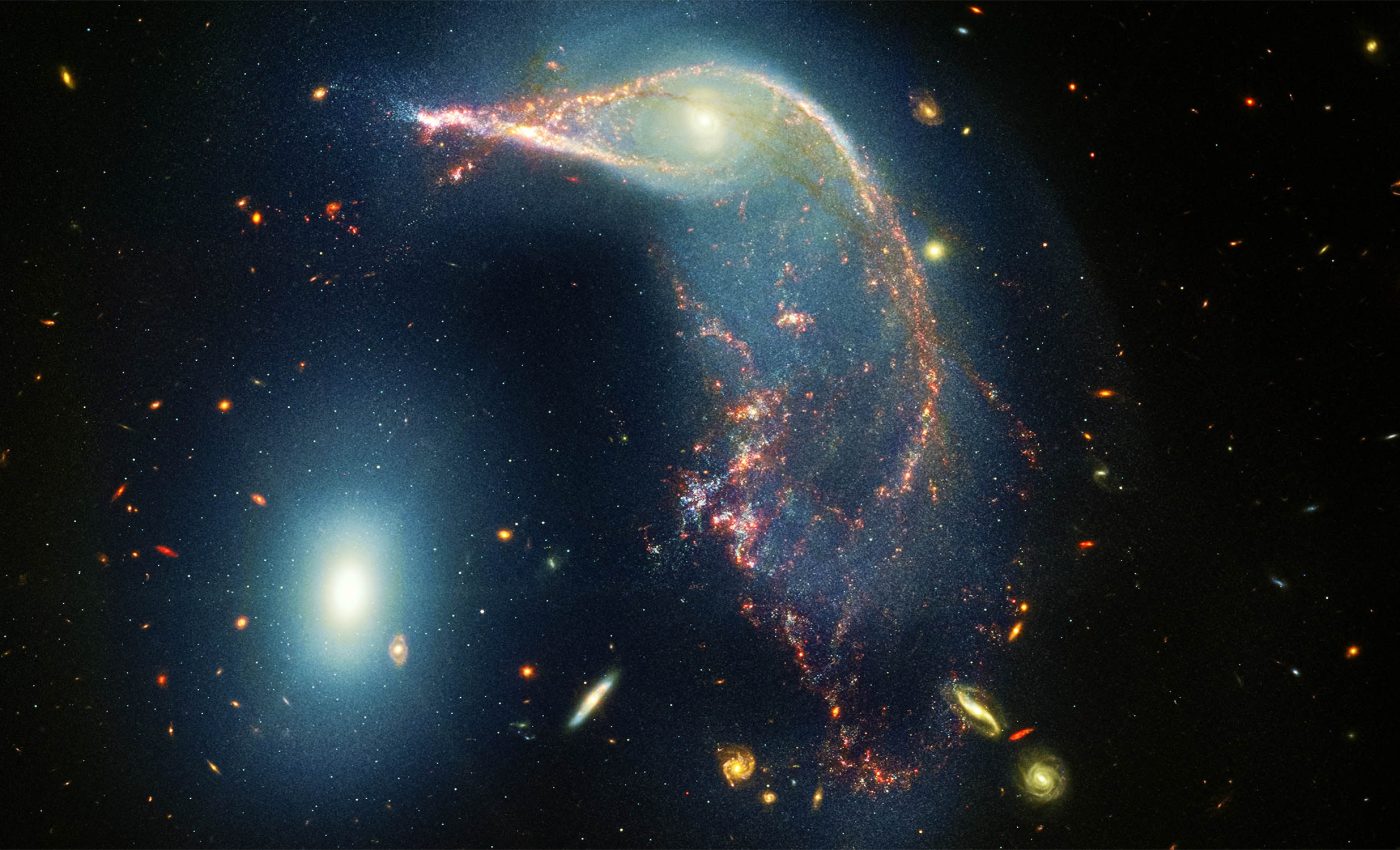
Interacting galaxies resemble a giant space penguin
A captivating symphony of two interweaving galaxies, named Arp 142, marks the second anniversary of NASA’s James Webb Space Telescope’s scientific operations.
The telescope’s round-the-clock observations have led to a cascade of extraordinary breakthroughs by astronomers globally.
Happy birthday to Webb
“Webb’s capabilities are shedding new light on our celestial surroundings and inspiring future generations of scientists, astronomers, and explorers,” added NASA Administrator Bill Nelson.
“Webb has continued to unlock the mysteries of the universe with remarkable images from the corners of the cosmos, going back nearly to the beginning of time.”
Mark Clampin, director of the Astrophysics Division at NASA Headquarters in Washington, also emphasized the James Webb Space Telescope‘s scientific prowess.
“In just two years, Webb has transformed our view of the universe, enabling the kind of world-class science that drove NASA to make this mission a reality,” he stated.
Its intricate observations are providing insights into longstanding mysteries about the early universe, while capturing awe-inspiring images that captivate people worldwide.
Webb telescope reveals Arp 142 galaxies
Webb’s expertise in capturing infrared light brings to view two galaxies, collectively known as Arp 142, engaged in a slow, celestial waltz.
The observations combine near- and mid-infrared light, rendering the galaxies joined by a visible blue haze. This haze is a mixture of stars and gas, a result of their cosmic interplay.
The galactic tango, set into action between 25 and 75 million years ago, will continue to evolve with the pair completing numerous loops before merging into a singular entity hundreds of millions of years down the line.
Arp 142: ‘Penguin’ and ‘Egg’ galaxies
Once a spiral galaxy, the ‘Penguin’ (individually cataloged as NGC 2936) now exhibits a gleaming galactic center resembling an eye, with its unwound arms shaping a beak, head, backbone, and fanned-out tail.
With ample gas and dust, the Penguin’s thinner areas underwent gravitational transformation, crashing in waves to form new stars.
On the other hand, the ‘Egg’ (NGC 2937), an elliptical galaxy, managed to maintain its compact shape, housing aging stars and significantly less gas and dust available for star formation.
Their near-equal mass ensures the smaller-looking Egg wasn’t consumed or distorted by its spiral counterpart.
Galactic penguin party
The galaxies are about 100,000 light-years apart – quite close in astronomical context. As a point of comparison, our Milky Way and the neighboring Andromeda Galaxy are 2.5 million light-years apart.
Looking further afield, another galaxy, cataloged PGC 1237172, lies 100 million light-years closer to Earth, teeming with new, blue stars.
But Webb’s mid-infrared-only imaging makes this galaxy practically invisible as it mainly captures cooler, older stars and substantial amounts of dust.
The backdrop of Webb’s image is filled with distant galaxies of varying shapes, testifying to the telescope’s sensitive and high-resolution infrared instruments.
Insights from Webb’s infrared spectroscopy
In addition to its stunning visual captures, the Webb Telescope has provided noteworthy insights through its infrared spectroscopy capabilities.
Webb analyzes light spectra from distant celestial objects. This helps identify chemical compositions, temperatures, and motion of various astronomical phenomena.
The technique reveals details about exoplanet atmospheres. It includes potential biosignatures. These hint at the possibility of life beyond our solar system.
Webb telescope discovers water vapor
One notable discovery is the detection of water vapor in exoplanet atmospheres. These exoplanets are located in the habitable zones of their stars. These findings fuel the quest to find Earth-like worlds which could potentially support life.
Webb’s spectroscopy has uncovered complex organic molecules in interstellar space. This discovery provides clues about the building blocks of life. It also sheds light on the processes that drive the formation of stars and planets.
“Webb’s infrared spectroscopy is like a magnifying glass for the cosmos, allowing us to peer into the chemical fingerprints of the universe. This tool is essential for mapping the intricate details of star formation, galaxy evolution, and even the search for extraterrestrial life,” said Jane Rigby, an astrophysicist at NASA’s Goddard Space Flight Center.
As Webb telescope gathers data, astronomers eagerly await new discoveries. These will shed light on the universe’s mysteries, from star births in distant galaxies to potential life on other worlds.
—–
Like what you read? Subscribe to our newsletter for engaging articles, exclusive content, and the latest updates.
Check us out on EarthSnap, a free app brought to you by Eric Ralls and Earth.com.
—–













